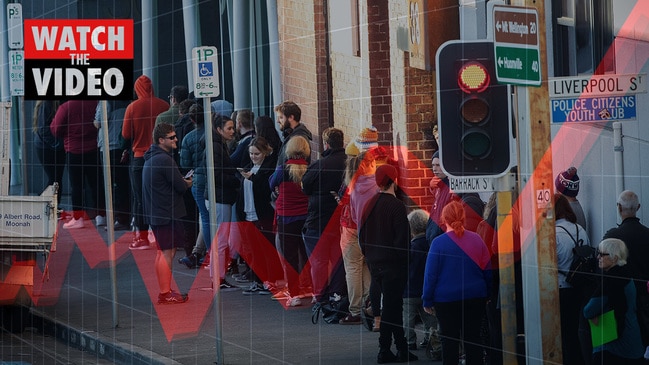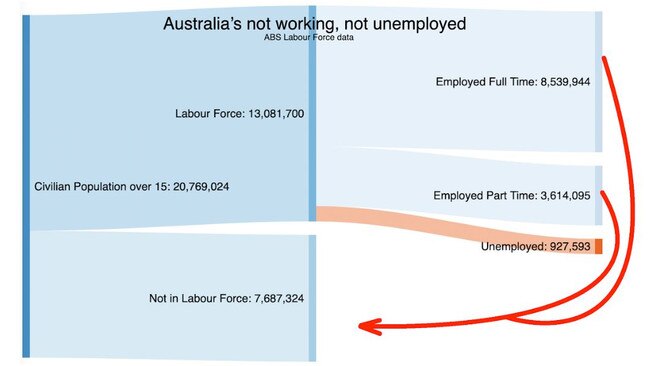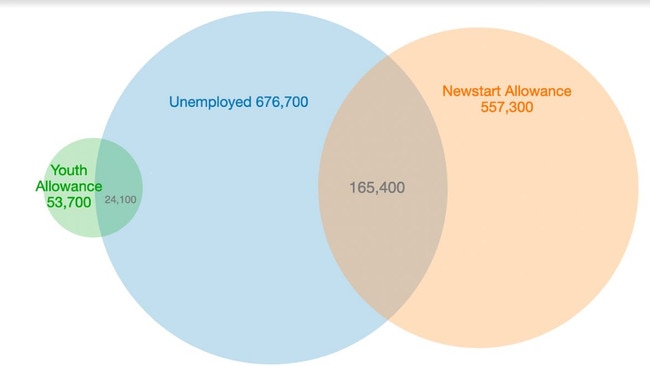Unemployment figure of 7.1% doesn’t show eveyone who’s lost their job
The official unemployment rate is currently at 7.1 per cent. But the huge number of Australians now without a job expose a myth about the dole.

Economy
Don't miss out on the headlines from Economy. Followed categories will be added to My News.
Unemployment shot up in the month of May to … 7.1 per cent? Hang on. That doesn’t seem terribly bad. Aren’t we supposed to be in the middle of a crisis of the scale of the Great Depression? What’s going on?
The answer is in how unemployment is measured. Lots of Australians have stopped looking for work. And that means they don’t get counted as unemployed.
As the next graph shows, Aussies dropped out of the labour force at a massive rate in April and May. Our labour force participation rate plummeted – falling far lower than it was during the 2008 Global Financial Crisis.
RELATED: Economic ‘bloodbath’ coming in 100 days
RELATED: Huge cost of Australia’s financial success

Labour force participation matters. If you’re not looking for work, you don’t get counted as unemployed. That makes sense – we don’t aim to count every retired person, full-time student or stay-at-home parent as unemployed. To get counted as unemployed you have to “actively look for work.”
What would happen if we tweak the statistics slightly?
As the next graph shows, if we pretend the labour force participation rate did not fall, and mark everyone who lost their job as unemployed, the Australian unemployment rate would have been over 11 per cent in May.

That is much worse. 7.1 per cent is the worst result in nearly two decades, but 11.4 per cent would be even worse than the 1991 recession.
Now, this is important: This article does not imply or insinuate a grand conspiracy. It’s normal for labour force participation to fall in bad times. And lower participation always moderates measured unemployment. It’s just that this time it has happened so fast. So to understand the unemployment rate at this peculiar point in history it is vital to know how the numbers are measured.
NOT UNEMPLOYED, NOT WORKING
The next chart shows how Australia is divided up. We have an adult population of almost 21 million. Around 13 million of us are in the labour force, and 7.7 million are not.
In the first half of this year hundreds of thousands of Australians lost their jobs. You might expect that when people lose their job they go straight into the unemployment category. Some do. But that’s not always the case. As the red arrows indicate, some of them end up ‘not in the labour force’.

There’s three big reasons people will have dropped out of the labour force. When there aren’t many jobs on offer, people naturally get discouraged from searching. With the virus running rampant, people are naturally nervous about heading to interviews. Under the new pandemic rules it is possible to collect unemployment benefits without looking for work.
ISN’T THE UNEMPLOYMENT RATE JUST EVERYONE ON THE DOLE?
Many people are surprised you can’t measure unemployment by counting the people on the dole. But here’s the thing – you can get the dole if you’re working a few hours a week. Meanwhile, many unemployed people don’t bother to register for the dole.
This leads to a surprising fact: most unemployed people are not on the dole and most people on the dole are not unemployed!
This Venn diagram shows what I’m talking about: There were just 165,400 Australians who were both unemployed and on Newstart in 2017-18 (Newstart is now known as JobSeeker).

Instead of looking at who is on the dole, the Australian Bureau of Statistics (ABS) measures unemployment with a survey. This is the world’s best practice, it is what the International Labour Organisation recommends, and what all the major countries do. The ABS is not mucking round – collecting data through surveys is what they do and they can get them to be very accurate.
They ask people if they worked, and if they say no, they ask them if they looked for work, and if they say yes to that, they are counted as unemployed. From this we measure the unemployment rate.
WHAT DOES THE FUTURE HOLD?
As the year goes on, a lot of Aussies will go back to work. And as the economy improves, the participation rate will lift too. The hard grind of looking for a job will start up again. People who are currently out of the labour force will polish up their resume, hit the jobs websites, and try to find themselves a job. What this will mean is that the unemployment rate will potentially go up as the economy starts to get better. It sounds paradoxical but when you understand how the unemployment rate is measured, you realise it could actually be good news.
Jason Murphy is an economist | @jasemurphy. He is the author of the book Incentivology.
Originally published as Unemployment figure of 7.1% doesn’t show eveyone who’s lost their job

